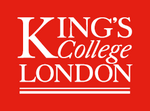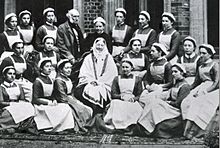
Back Nightingale School of Nursing German مدرسه عالی پرستاری و مامایی فلورانس نایتینگل Persian Florence Nightingale Betegápolási és Szülészeti Iskola Hungarian ナイチンゲール看護学校 Japanese 나이팅게일 간호 학교 Korean Nightingale School of Nursing Swedish 南丁格爾護理學及助產學院 Chinese
 | |
Former names | – The Nightingale Training School and Home for Nurses – Nightingale School of Nursing – Florence Nightingale School of Nursing and Midwifery |
|---|---|
| Established | 9 July 1860 |
Parent institution | King's College London |
| Head of School | Ian Norman |
| Location | |
| Website | www |
 | |


The Florence Nightingale Faculty of Nursing, Midwifery & Palliative Care is an academic faculty within King's College London. The faculty is the world's first nursing school to be continuously connected to a fully serving hospital and medical school (St. Thomas' Hospital).[3] Established on 9 July 1860 by Florence Nightingale, the founder of modern nursing, it was a model for many similar training schools through the UK, Commonwealth and other countries for the latter half of the 19th century.[4] It is primarily concerned with the education of people to become nurses and midwives. It also carries out nursing research, continuing professional development and postgraduate programmes. The Faculty forms part of the Waterloo campus on the South Bank of the River Thames and is now one of the largest faculties in the university.
The school is ranked as the number one faculty for nursing in London[5] and in the United Kingdom[6] whilst third in the world rankings[7] and belongs to one of the leading universities in health services, policy and research in the world.[8][9][10][11] A freedom-of-information request in 2015 disclosed that the Florence Nightingale Faculty of Nursing and Midwifery had one of the lowest admission offer rates of 14% to its applicants.[12]
The faculty specialises in the following areas: child and adolescent nursing; midwifery and women's health; adult nursing; mental health nursing; and postgraduate research, with programmes catering to the needs of a wider range of individuals and healthcare professionals continuing their professional development.
- ^ "Florence Nightingale Faculty of Nursing, Midwifery & Palliative Care Address".
- ^ "Florence Nightingale: The School for Nurses". www.countryjoe.com.
- ^ Petroni, A (1969). "[The first nursing school in the world—St. Thomas Hospital School in London]". Munca Sanit. 17 (8): 449–54. PMID 5195090.
- ^ Daly, John; Speedy, Sandra; Jackson, Debra (2009). Contexts of Nursing (3 ed.). Elsevier Australia (Churchill Livingstone). p. 41. ISBN 9780729539258.
- ^ The Complete University Guide (2 October 2015). "University Subject Tables 2016: Nursing – London". The Complete University Guide. Retrieved 2 October 2015.
- ^ QS (30 April 2016). "QS World University Rankings by Subject 2016 – Nursing". QS. Retrieved 30 April 2016.
- ^ QS (30 April 2017). "Nursing". QS. Retrieved 14 May 2017.
- ^ "Key Facts". King's Health Partners. Archived from the original on 31 October 2010. Retrieved 17 October 2015.
- ^ "World Reputation Rankings 2015 results". Times Higher Education. 4 June 2015. Retrieved 26 September 2015.
- ^ "University Research Excellence Framework 2014 – the full rankings". The Guardian. Retrieved 7 October 2015.
- ^ "2014–2015 World Ranking (1–250)". Middle East Technical University. Archived from the original on 14 December 2018. Retrieved 7 October 2015.
- ^ "Breakdown of undergraduate admissions statistics - a Freedom of Information request to King's College London" (PDF). 11 July 2015.
© MMXXIII Rich X Search. We shall prevail. All rights reserved. Rich X Search